
Simple Wound Care Page Menu: 1 2 3 4 5 6 Next>>
Simple Wound Care in the Golden Age of Piracy, Page 4
Securing the Wound Lips - Encouraging the Regeneration of Flesh
Nearly all surgical authors writing on wound care suggest that topical medicines be applied to the site for promotion of flesh. The widest variety of them appear in sea surgeon John Atkins' book. He first lists 27 medicines that can serve as 'Vulneraria' (vulneraries or wound healing medicines). To help those who wish to understand the nature of these medicines, the ones that are found in my Sea Surgeon's Dispensatory article are linked there, while those not found there are linked to Wikipedia:
Atkins adds a list of another 22 medicines her titles 'Balsamica' (balsamics or restorative and curative medicines). He suggests making them into "into Teas or Decoctions, adding a little White-Wine for common ·Drink. Mr. [Richard] Wiseman advises some of them in Broth... with Eggs and Jellies."2 These include:
Although not quite as extensive as Atkins' list, fellow sea surgeon John Woodall also recommends a variety of topical medicines for building flesh in wounds.
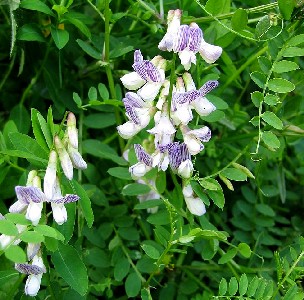
Photo: Berger Harald - Vicia sylvatica or Wood Vetch
The medicaments incarnative, or for regeneration of flesh, are the flower of Barley, Beanes, Lupines and Crobus [wood vetch], Myrrhe, Aloes. Thus [Frankincense] Aristolochia & Iris, which are used either by themselves, or mixed with turpentine, Mel Rosarum [Honey of Roses] Syrupe of dry Roses, the yolke of an egge, or the like: also Bazilicum magnum, Unguentum aureum, are good incarnatives, the Emplastrum gratia Dei [The Grace of God Plaster - made of turpentine, pitch, white wax, mastic, betony, vervain and burnet], made of juyce of hearbes, the Emplaster of betony, dissolved with Axungia porcina [pork lard], and follow the generall rules, let the dry [wound] bee more humected [moistened], and the humid more desiccated [dried].4
Woodall's last comment most likely refers to humors - medicines (as well as anything else ingested) were assigned four characteristics: dry, moist, hot and cold. Dry medicines were most effective for moist problems and so forth. (How a wound was determined to be moist or dry is not explained.)
In his book on turpentine, sea surgeon James Yonge (not surprisingly) recommends turpentine for healing wounds. He explains that "It solely and perfectly healeth Punctures, and incised Wounds by Symphysis [growing together]; (where neither of them are very large), and that maugre [in spite of] its digestive Faculty."5 Turpentine clearly had a place in wound healing, being suggested by nearly every other surgeon under study for this purpose.
French surgeon Ambroise Paré recommends topical medicines that "are Agglutinative
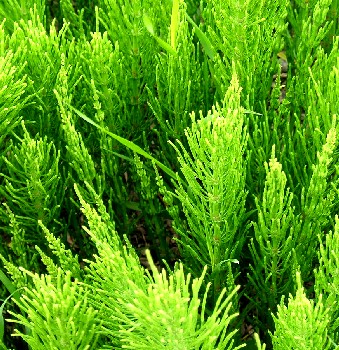
Photo: Wiki user MPF - Horsetail (Equisetum arvense)
[adhesive], which ought to be indued [endowed] with a drying and astrictive [binding] quality, whereby they may hold together the lips of the wound, and drive away defluxion [flows of fluids/humors], having alwayes regard to the nature of the part and the greatnesse of the disease."6 Here again we see concern for humoral qualities of the medicines as well as how they interact with the bodily humors. Like most of his peers, Paré goes on to advise the use of a variety of medicines, several of which should be familiar after reading the previous entries. They include:
Olibanum [Frankincense], Aloes, Sarcocolla[gum resin from shrubs found in Africa], Bole-Armenick [a red astringent Armenian clay], Terra sigillata [sealed earth], Sanguis Draconis [Dragon’s Blood], Common and Venice Turpentine, Gumme Elemnii [gum resin], Plantane, Horse-tayle, the greater Comfrey, Farina Volatilis [mill dust], and many other things of this kind7
Richard Wiseman also provides a list of ingredients including some complex preparations that contain many familiar elements listed previously such as dragon's blood, gum elemni, frankincense, aloes, turpentine, and mastic, among others.8
Of perhaps more interest are the medicines Wiseman prescribes in a case study on dry suturing:
Then I dressed up the Wounds with Arcem's Liniment [Linamentum Arcæi - a digestive medicine of mutton fat, gum elemi and turpentine] and empl[aster] è bolo [a plaster composed of oil, litharge or elemental lead, and sealed earth], with a Compress dipt in Oxycrate [vinegar and water, used as an astringent], and made my Bandage over all.9
1,2,3 John Atkins, The Navy Surgeon, 1742, p. 170; 4 John Woodall, the surgions mate, 1617, p. 131; 5 James Yonge, Currus Triumpalis, é Terebinthô., p. 63; 6,7 Ambroise Paré, The Workes of that Famous Chirurgion Ambrose Parey, 1649, p. 255; 8 Richard Wiseman, Severall Chirurgicall Treatises, 1676, p. 348; 9 Wiseman, p. 361
Step 4 of Simple Broken Skin Wound Care: Maintain Wound Temperament
This is probably the most challenging of the four steps for the modern reader to understand, primarily because of the use of the word 'temperament'. In his 1706 Dictionary, Edward Phillips defines temperament as "a proper and proportionable Mixture of the Elements,
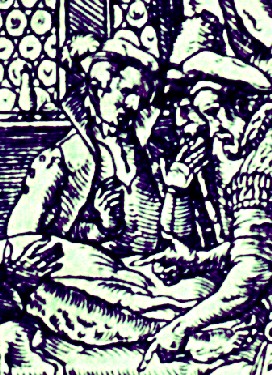
Discussing Leg Wound Treatment, From
Paracelsus
Opus Chyrurgicum, plate 175 (1565)
but more especially of the Humours of a Humane Body; the usual Constitution, Complexion, or Habit of the Body"1. Based on that definition, the purpose of this step was clearly to keep the bodily humors (fluids) as close to normal as possible. Wounds were believed to corrupt humors, which in turn caused the wound to become infected. As Richard Wiseman explains, humor-diverting techniques are required both "to prevent the Influx of Humours, and evacuate that which already affecteth the Wound."2 To prevent this, some humoral treatments were used to divert humors away from the wound site where they may become corrupt.
A variety of humor-based treatments are suggested in period surgical manuals to maintain wound temperament - some direct, others indirect.
Direct Humor Treatments
Among the methods used to directly impact the body's humors include bleeding, purging up (via emetics) and purging down (primarily via enemas, although diuretic and laxative medicines were occasionally used as well). Ambroise Paré comments that phlebotomy (bleeding) and purging have the "force to divert and hinder defluxion [discharges of unwanted humors], whereby the temper of the part might be in danger of change"3. Richard Wiseman likewise says, "Humours ought to be diverted from the Wound by the Universal Regiment set down of Bleeding, Purging, &c."4 Sea surgeon John Woodall suggests that 'The universall regiment' for wound care includes purging via 'potions', although he does not mention bleeding.5 On the other hand, sea surgeon John Atkins recommends "an exact Regimen, [with] large Bleeding", but no mention of purging.6
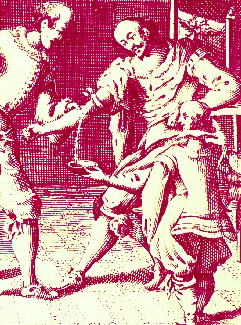
Venesection of the Arm, From Nuova et
Utlilssima Prattica, by Cintio d'Amato,
p. 41 (1671)
While Paré recognized the virtue of bleeding in wounds, he also advised that "Phlebotomy ...is not alwayes necessary, as in small wounds and bodies, which are neither troubled with ill humours, nor plethoricke [a humoral body type said to be 'congested' with blood]: But it is onely required in great [large] wounds, where there is feare of defluxion [fluid discharge from the wound], paine, Delirium, Raving and unquietnesse"7. He also warns, "Gentle purgations [vomits] must bee appointed, because the humours are moved and inraged by stronger [purges]; whence there is danger of defluxion and inflammation"8.
Enemas were a popular treatment for ill patients, designed to purge unwanted humors from the body 'downwards' as well as allowing food to be effectively processed and turned into 'good' humors. John Atkins recommended "keeping the Body soluble [keeping the digestive tract open] with Clysters [enemas] or Suppositories"9. Another facet of Woodall's universal regimen was purging using 'glisters' (clysters) so "the naturall temperaments of the part be carefully preserved".10
Richard Wiseman mentions emetics to purge 'upwards' via vomiting, particularly in the case of gunshot wounds, which are admittedly a little outside the scope of this article. Nevertheless, the principles can be applied. Wiseman explains,
Purging avails much for the carrying off bilious [bile-based, produced by the liver] and serous [the serum-based portion of phlegm] Humours, which from their heat and tenacity are most apt to ferment and flow into these Wounds, and cause Pain, Inflammation, and other ill Symptoms [complications]. In which cases, cassia, manna, tamarind. syr de cichor. cum rhubarb. ros. solut. are prescribed and may be taken in Whey or Ptisans.11
1 Edward Phillips, Dictionary: The new world of words, 6th ed., 1706, not paginated; 2 Richard Wiseman, Severall Chirurgicall Treatises, 1676, p. 417; 3 Ambroise Paré, The Workes of that Famous Chirurgion Ambrose Parey, 1649, p. 255; 4 Wiseman, p. 349; 5 John Woodall, the surgions mate, 1617, p. 128; 6 John Atkins, The Navy Surgeon, 1742, p. 169; 7,8 Paré, p. 255; 9 Atkins, p. 169-70; 10 Woodall, p. 128; 11 Richard Wiseman, Severall Chirurgicall Treatises, 1676, p. 414
Indirect Humor Treatments
While bleeding and purging were dramatic ways to directly affect wound temperament, a number of indirect methods were also employed. These were designed to create an environment within the body that would facilitate the creation of 'good' humors which would nurture and allow the body to heal. They included maintaining the heat of the wound, proper diet and keeping the patient well rested and in a balanced emotional state.
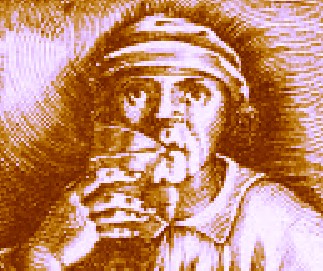
Artist: Jan van der Straet (1600)
Maintaining the heat at the wound site through the use of medicines is also considered important to its cure according to some period surgeons. Sea surgeon John Woodall explains that the use of medicines "which confirme and strengthen the naturall heat of the member debilitated" as well as prevent matter and humors from forming and leaking out of the wound are important to healing.1 Among the medicines he uses are Ceratum Refrigerant (cold cream) and an Unguent of Red Lead (Unguentum de Minio). Sea surgeon James Yonge again recommends turpentine, explaining that "it warms and comforts those [wounds], wherein, from any cause the spirits and native heat is destroyed, or impaired"2.
Although he doesn't advise particular medicines for generating warmth, sea surgeon John Atkins does say that the patient is to be kept in "a warm Air" which may also be related to this idea.3 Sea surgeon John Woodall similarly addresses a complication of wounds he calls ''intemperature', which he defines as 'over much heat or cold'. His solution to this problem is simply to fix it "by opposites, as namely to too hot intemperance apply a cold medicament, &c."4
Another option was keeping the patient to a diet that was best for effective wound healing. Atkins explains, "The less the Bowels labour in their several Offices by a Subtraction of Meat and Drink, provided there is enough taken in to sustain Life, the better in these Cases goes on the Work of healing"5. He later suggests a "Diet of Vegetables."6 Woodall advises "a sober and frugall dyet, abstinence from wine, venerie [drinking too much], and all kindes of meats which may move or attenuate [alter] humors, & moderate use of good nourishing sustenance, all which helps the poore Sea-man is capable of in long voyages."7
Ambroise Paré has a great deal to say about diet and its impact on
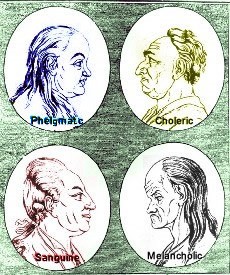
The Four Humoral Body Types, From
Physiognomische Fagmente,
By J.C. Lavaters (1792)
facilitating wound healing. "A slender cold, and moyst Diet must be observed until that time be passed, wherein the patient may be safe and free from accidents which are usually feared."8 The reference to 'cold' and 'moist' might refer to the temperature and type of food the patient eats, but it more likely has to do with the humoral qualities of the food. (Here again we are referring to the four humoral qualities of hot, cold, dry and moist which was believed to be an integral part of all ingested substances.) Paré goes on to explain the importance of diet in wounds, specifically referencing humorism by referring to some of the four humor-based body types (See the image at right.). He advises that the patient
bee fed sparingly, especially if he be plethorick [sanguine]; he shall abstaine from salt and spiced flesh, and also from wine; If he shall be of a Cholerick [hot and dry humor-based personality - energetic] or Sanguine [hot and wet humour-based personality - fun-loving] nature: In steed of wine he shall use the decoction of Barly or Liquerice, or Water and Sugar... When hee shall seeme to bee past danger it will bee time to fall by little and little to his accustomed maner of diet and life.9
Paré elsewhere expands on the reason behind a spare diet. Such a diet diverts humors away from the wound site, "for the stomach being empty and not well filled, draws from the parts about it, whereby it consequently follows, that the utmost and remotest parts are at the length evacuated"10.
Richard Wiseman has similar advice for a patient's diet, explaining that "in great Wounds it is necessary to observe a spare one, as Barly grewels [gruel], Panadoes [Panada - a mixture of flour, water, or of breadcrumbs soaked in milk], thin Broth, or a Potched [poached] Egge, this much availing to the preventing of Inflammation. But in this the Patient's custome [usual diet] must be considered."11
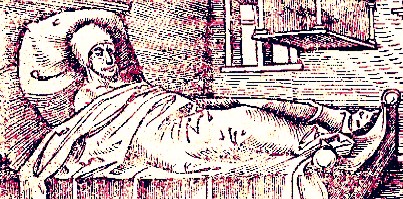
A final recommendation was to keep the patient well rested and in a good emotional state. Atkins advises the patient to be placed "a quiet soft Position in Bed"12. Ambroise Paré suggests that the patient is to "keepe himselfe quiet; for rest is... the very best Medicine."13 Paré further directs the surgeon to have the patient "avoyde Venery [Sex], Contentions [disagreements], Brawles, Anger, and other perturbations of the minde."14 Paré explains that sex "is very pernicious, for that it inflames the spirits and humors far beyond other motions; whereby it happens that the humors waxing hot, are too plentifully carried to the wounded and over heated part."15 Atkins expands upon the idea behind keeping a patient calm and rested. The "Cure when any Hopes remain, lays in one general Design; and that is, procuring an easy languid Circulation: Whatever excites Uneasiness, (stirring or Medicine) puts the Blood in quicker Motion, irritates and does hurt."16
1 John Woodall, the surgions mate, 1617, p. 128; 2 James Yonge, Currus Triumpalis, é Terebinthô., p. 85; 3 John Atkins, The Navy Surgeon, 1742, p. 169; 4 Woodall, p. 129; 5,6 Atkins,p. 169; 7 Ambroise Paré, The Workes of that Famous Chirurgion Ambrose Parey, 1649, p. 255; 8 Atkins,p. 169; ,9, Paré, p. 255; 10 Richard Wiseman, Severall Chirurgicall Treatises, 1676, p. 414; 11, Paré, p. 321; 12 Atkins, p. 169; 13,14 Paré, p. 255; 15 Paré, p. 321 16 Atkins, p. 169

